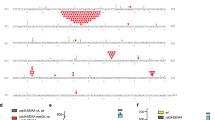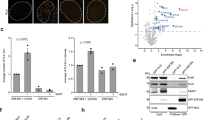Abstract
The discovery of homologues from the yeast Saccharomyces cerevisiae of the human Ku DNA-end-binding proteins (HDF1 and KU80) has established that this organism is capable of non-homologous double-strand end joining (NHEJ)1,2,3,4,5, a form of DNA double-strand break repair (DSBR) active in mammalian V(D)J recombination6,7,8. Identification of the DNA ligase that mediates NHEJ in yeast will help elucidate the function of the four mammalian DNA ligases in DSBR, V(D)J recombination and other reactions9,10. Here we show that S. cerevisiae has two typical DNA ligases, the known DNA ligase I homologue CDC9 (refs 11,12, 13, 14) and the previously unknown DNA ligase IV homologue DNL4. dnl4 mutants are deficient in precise and end-processed NHEJ. DNL4 and HDF1 are epistatic in this regard, with the mutation of each having equivalent effects. dn14 mutants are complemented by overexpression of Dnl4 but not of Cdc9, and deficiency of Dnl4 alone does not impair either cell growth or the Cdc9-mediated responses to ionizing and ultraviolet radiation. Thus, S.cerevisiae has two distinct and separate ligation pathways.
This is a preview of subscription content, access via your institution
Access options
Subscribe to this journal
Receive 51 print issues and online access
$199.00 per year
only $3.90 per issue
Buy this article
- Purchase on Springer Link
- Instant access to full article PDF
Prices may be subject to local taxes which are calculated during checkout




Similar content being viewed by others
References
Feldmann, H. & Winnacker, E. L. Aputative homologue of the human autoantigen Ku from Saccharomyces cerevisiae. J. Biol. Chem. 268, 12895–12900 (1993).
Milne, G. T., Jin, S., Shannon, K. B. & Weaver, D. T. Mutations in two Ku homologs define a DNA end-joining repair pathway in Saccharomyces cerevisiae. Mol. Cell. Biol. 16, 4189–4198 (1996).
Boulton, S. J. & Jackson, S. P. S. cerevisiae Ku70 potentiates illegitimate DNA double-strand break repair and serves as a barrier to error-prone DNA repair pathways. EMBO J. 15, 5093–5103 (1996).
Moore, J. K. & Haber, J. aE. Cell cycle and genetic requirements of two pathways of nonhomologous end-joining repair of double-strand breaks in S. cerevisiae. Mol. Cell. Biol. 16, 2164–2173 (1996).
Boulton, S. & Jackson, S. Identification of a Saccharomyces cerevisiae Ku80 homologue: roles in DNA double strand break rejoining and in telomeric maintenance. Nucleic Acids Res. 24, 4639–4648 (1996).
Lieber, M. R. Immunoglobulin diversity: rearranging by cutting and repairing. Curr. Biol. 6, 134–136 (1996).
Weaver, D., Boubnov, N., Wills, Z., Hall, K. & Staunton, J. V(D)J recombination: double-strand break repair gene products used in the joining mechanism. Ann. N.Y. Acad. Sci. 764, 99–111 (1995).
Jeggo, P. A., Taccioli, G. E. & Jackson, S. P. Ménage à trois: double strand break repair, V(D)J recombination and DNA-PK. Bioessays 17, 949–957 (1995).
Lindahl, T. Recognition and processing of damaged DNA. J. Cell. Sci. (suppl.) 19, 73–77 (1995).
Lindahl, T. & Barnes, D. E. Mammalian DNA ligases. Annu. Rev. Biochem. 61, 251–281 (1992).
Wilcox, D. R. & Prakash, L. Incision and postincision steps of pyrimidine dimer removal in excision-defective mutants of Saccharomyces cerevisiae. J. Bacteriol. 148, 618–623 (1981).
Tomkinson, A. E., Tappe, N. J. & Friedberg, E. C. DNA ligase I from Saccharomyces cerevisiae: physical and biochemical characterization of the CDC9 gene product. Biochemistry 31, 11762–11771 (1992).
Moore, C. W. Ligase-deficient yeast cells exhibit defective DNA rejoining and enhanced gamma ray sensitivity. J. Bacteriol. 150, 1227–1233 (1982).
Barker, D. G., White, J. H. & Johnston, L. H. The nucleotide sequence of the DNA ligase gene (CDC9) from Saccharomyces cerevisiae: a gene which is cell-cycle regulated and induced in response to DNA damage. Nucleic Acids Res. 13, 8323–8337 (1985).
Hsieh, C. L., Arlett, C. F. & Lieber, M. R. V(D)J recombination in ataxia telangiectasia, Bloom's syndrome, and a DNA ligase I-associated immunodeficiency disorder. J. Biol. Chem. 268, 20105–20109 (1993).
Petrini, J., Donovan, J. W., Dimare, C. & Weaver, D. T. Normal V(D)J coding junction formation in DNA ligase I deficiency syndromes. J. Immunol. 152, 176–183 (1994).
Wei, Y. F. et al. Molecular cloning and expression of human cDNAs encoding a novel DNA ligase IV and DNA ligase III, an enzyme active in DNA repair and recombination. Mol. Cell. Biol. 15, 3206–3216 (1995).
Robins, P. & Lindahl, T. DNA ligase IV from HeLa cell nuclei. J. Biol. Chem. 271, 24257–24261 (1996).
Siede, W., Friedl, A. A., Dianova, I., Eckardt-Schupp, F. & Friedberg, E. C. The Saccharomyces cerevisiae Ku autoantigen homologue affects radiosensitivity only in the absence of homologous recombination. Genetics 142, 91–102 (1996).
Grawunder, U. et al. Activity of DNA ligase IV stimulated by complex formation with XRCC4 protein in mammalian cells. Nature 388, 492–495 (1997).
Schuler, G. D., Altschul, S. F. & Lipman, D. J. Aworkbench for multiple alignment construction and analysis. Proteins: Struct. Funct. Genet. 9, 180–190 (1991).
Baudin, A., Ozier-Kalogeropoulos, O., Denouel, A., Lacroute, F. & Cullin, C. Asimple and efficient method for direct gene deletion in Saccharomyces cerevisiae. Nucleic Acids Res. 21, 3329–3330 (1993).
Gyuris, J., Golemis, E., Chertkov, H. & Brent, R. Cdi1, a human G1 and S phase protein phosphatase that associates with Cdk2. Cell 75, 791–803 (1993).
Ito, H., Fukuda, Y., Murata, K. & Kimura, A. Transformation of intact yeast cells treated with alkali cations. J. Bacteriol. 153, 163–168 (1983).
Acknowledgements
We thank M. Johnston for reagents for yeast-gene disruption, and for helpful discussion on the design of these experiments. T.E.W. is a Howard Hughes Medical Institute physician postdoctoral fellow. This research is supported by NIH grants to M.R.L. M.R.L. is a Leukemia Society of America Scholar.
Author information
Authors and Affiliations
Corresponding author
Rights and permissions
About this article
Cite this article
Wilson, T., Grawunder, U. & Lieber, M. Yeast DNA ligase IV mediates non-homologous DNA end joining. Nature 388, 495–498 (1997). https://doi.org/10.1038/41365
Received:
Accepted:
Issue Date:
DOI: https://doi.org/10.1038/41365
This article is cited by
-
DNA repair- and nucleotide metabolism-related genes exhibit differential CHG methylation patterns in natural and synthetic polyploids (Brassica napus L.)
Horticulture Research (2021)
-
Rapid poxvirus engineering using CRISPR/Cas9 as a selection tool
Communications Biology (2020)
-
Radiation-induced DNA damage and repair effects on 3D genome organization
Nature Communications (2020)
-
Structures of DNA-bound human ligase IV catalytic core reveal insights into substrate binding and catalysis
Nature Communications (2018)
-
Efficient gene targeting in non-homologous end-joining-deficient Lipomyces starkeyi strains
Current Genetics (2017)
Comments
By submitting a comment you agree to abide by our Terms and Community Guidelines. If you find something abusive or that does not comply with our terms or guidelines please flag it as inappropriate.



